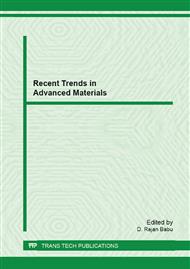p.401
p.406
p.411
p.415
p.423
p.428
p.435
p.440
p.445
A Theoretical Investigation on the Dimensions and Annealing Effects of InAs/GaAs Quantum Dots for Device Applications at High Bit-Rate Optical Transmission Window of 1.3-1.55 μm
Abstract:
In this paper, we present theoretical model and computations for tuning the photoluminescence (PL) emission of InAs/GaAs quantum dots at 1.3 -1.55 μm by optimizing its height and base dimensions through quantum mechanical concepts. Simulation on the annealing induced compositional change in the QDs was carried out using Fick’s diffusion model. Results from our computation illustrated that lower base size of 10 nm and larger height QDs of 5.1 nm can be effectively utilized for extending the PL emission to longer wavelengths with minimal blue-shift on annealing. This highlights the potential of our model and computation to assist in precisely engineering the optical properties of QD materials for specific device applications.
Info:
Periodical:
Pages:
423-427
Citation:
Online since:
October 2012
Authors:
Keywords:
Price:
Сopyright:
© 2012 Trans Tech Publications Ltd. All Rights Reserved
Share:
Citation:


